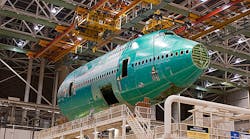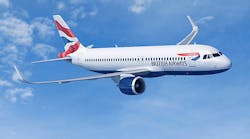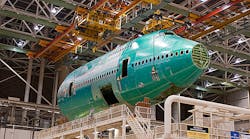Boeing Commercial Airplanes announced it will reduce its production rate for the 747-8 program, explaining it intends to match supply with near-term demand for cargo aircraft. Assembly of the aircraft at Boeing’s 747 production lines in Everett, Wash., will be reduced from one jet per month to one jet every two months, or half a jet/month, starting in September.
Midway through last year the jet-builder set a production rate cut to 1.3 per month, which will take effect in March.
Related to the production cut, The Boeing Co. will take a $569-million after-tax charge ($0.84 per share) in its Q4 2015 report.
Current demand for the 747 is so slow that in its monthly summary of orders and deliveries for December 2015 Boeing listed just 20 747s on order for the year.
As airlines and air-leasing companies have shifted their wide-body preferences to Boeing’s 777 and 787 Dreamliner programs, the future of the 747 program seems to rely on demand from the air-cargo market, but that possibility remains uncertain for now. "Global air-passenger traffic growth and airplane demand remain strong, but the air-cargo market recovery that began in late 2013 has stalled in recent months and slowed demand for the 747-8 Freighter," explained Ray Conner, Boeing vice chairman and president and CEO of Boeing Commercial Airplanes.
Boeing noted that most recent air-transport industry data show that air freight contracted in November, with volumes declining 1.2% year/year. (Global passenger demand grew 5.9% over the same period, higher than the 10-year average rate, Boeing noted.)
"While we remain confident in the 747-8's unique value-proposition and an upcoming replacement cycle for late-model 747-400 Freighters, we're taking the prudent step to further align production with current market requirements," Connor added.
"We are closely monitoring the air-cargo market as we work to win additional orders to support ongoing future production," said Boeing’s Greg Smith, executive vice president of Business Development & Strategy and chief financial officer. “At the same time, we continue to aggressively drive productivity to lower costs across our production system to offset the current market challenges.”
The 747-8 is the third-generation of the 747, with an extended fuselage and wings reconfigured from the original design introduced in 1970. It is the largest version of the 747, and the largest commercial aircraft built in the U.S. It is powered by the GE Aviation GEnx turbofan jet engine, the same units available on Boeing’s new long-range aircraft, the 787.
In June 2015, Boeing cut the production rate for the 747-8 from 1.5 to 1.3 planes per month, at that time saying it was adjusting to the continued decline in demand for the once prevalent “jumbo jets” that once symbolized Boeing’s command of the commercial aircraft state-of-the-art “jumbo jets.”










